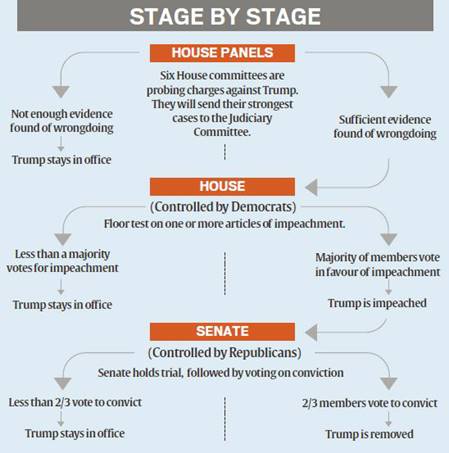



Madhya Pradesh Govt nod to indirect polls for mayor posts, BJP cries foul
Government of Madhya Pradesh cleared a proposal to hold indirect elections for the posts of mayors and presidents of municipal bodies.
Currently, voters cast two votes, one to elect the mayor or the president, and the other to elect the councillor in their respective wards.

- Can be hold accountable to the voters for their performance.
- This would give voters a direct connection to their mayor.
- He or she would be able to run on a personal vision of what his city needs.
- Run the town without worrying about a majority in the council.
- Not vulnerable to the shifting sands of politics or the prejudices of councillors.
- Because of the existence of different committees and the task of carrying along members, decision-making is likely to be impeded, making the ULB less efficient.
- The system replicates the cabinet system of governance at the federal and state levels and therefore, is in keeping with those forms of government.
- The system allows for broader consultation in the process of decision-making and conforms to the democratic principles of an inclusive process.
- Individualising local power, on the one hand, could lead to arbitrariness and on the other, to poor governance on account of lack of broad consultation.
- It permits many more elected members to play significant roles and take up vital responsibilities.
- Since the mayor would be elected from among the members of the party/coalition that has a majority in the ULB, possible gridlock situations are avoided.
President Ram Nath Kovind will visit Odisha’s Khorda district to lay the foundation of a memorial dedicated to the 1817 Paika Rebellion.
- Paikas had been recruited since the 16th century by kings in Odisha from a variety of social groups to render martial services in return for rent-free land (nish-kar jagirs) and titles.
- The British introduced new revenue settlements, due to which many Odia proprietors ended up losing their lands to absentee Bengali landlords.
- Changes in the currency and revenue systems meant the Odias had to pay taxes in silver, which was more expensive for them, and resulted in their further marginalisation and oppression.
- In 1817, some 400 Kondhs, who belonged to the state of Ghumsur, banded together to revolt against the British under leadership of Bakshi Jagabandhu Bidyadhar Mohapatra.
- During the course of the rebellion, government buildings in Banapur were set on fire, policemen and British officials were killed, and the treasury was looted.
- The uprising lasted for a few months but was eventually crushed by the better-equipped and trained forces of the East India Company.
- Paika Rebellion is one among the peasant rebellions that took place in India when the British East India Company was expanding its military enterprise.
- Because these uprisings violently clashed with European colonialists and missionaries on many occasions and therefore considered to be “nationalist” in nature.
US House of Representatives Speaker announced that the House would launch an impeachment inquiry against President Donald Trump, over his alleged efforts to pressure Ukraine to investigate Joe Biden, Trump’s potential rival in the 2020 elections.
- Impeachment is a provision that allows Congress to remove the President of the United States.
- Under the US Constitution, the House of Representatives (Lower House) has the “the sole power of impeachment” while the Senate (Upper House) has “the sole power to try all impeachments”.
- The Chief Justice of the US Supreme Court has the duty of presiding over impeachment trials in the Senate.
- The President can be removed from office for “treason, bribery, or other high crimes and misdemeanours”.
- Essentially, it means an abuse of power by a high-level public official. This does not necessarily have to be a violation of an ordinary criminal statute.
- Historically, in the US, it has encompassed corruption and other abuses, including trying to obstruct judicial proceedings.
Impeachment Process:

HOUSE VOTE: It begins with an investigation by a House committee. In Trump’s case, six committees are investigating him on impeachable offences. If they find that there is enough evidence of wrongdoing, it will refer the matter to the full House. When the full House votes, if one or more of the articles of impeachment gets a majority vote, the President is impeached.
SENATE TRIAL & VOTE: The Senate holds a trial, overseen by the chief justice of the Supreme Court. A team of lawmakers from the House, known as managers, play the role of prosecutors. The President has defence lawyers, and the Senate serves as the jury. If at least two-thirds of the Senators present find the President guilty, he is removed and the Vice President takes over as President.
Impeachment History:
- No US President has ever been removed as a direct result of impeachment.
- The House did impeach two Presidents — Andrew Johnson (1968) and Bill Clinton (1998) — but the Senate did not convict them.
Reference: https://indianexpress.com/article/explained/explained-how-a-us-president-can-be-impeached-6029188/
The 23rd edition of the Trilateral Maritime Exercise MALABAR, is scheduled between the navies of India, Japan and USA from 26 Sep to 04 Oct 19 off the coast of Japan.
- MALABAR 2019 would endeavour to further strengthen India - Japan - US Naval cooperation and enhance interoperability, based on shared values and principles.
- The Exercise would encompass conduct of complex maritime operations in the surface, sub-surface and air domains, and focus on Anti-Submarine Warfare, Anti-Air and Anti-Surface Firings, Maritime Interdiction Operations (MIO) including Visit Board Search and Seizure (VBSS) and tactical scenario based Exercise at Sea.
- In addition, the partner navies would conduct official protocol visits, professional interactions including Subject Matter Expert Exchanges (SMEE), reciprocal ship visits, sports fixtures and social events during the harbour phase.
Source: The Pib

© 2025 iasgyan. All right reserved